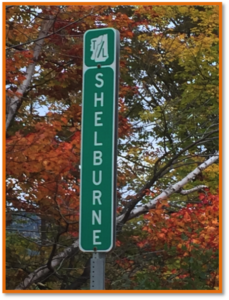PRESIDENT’S COLUMN
Geography in a Post-Truth World
By Glen M. MacDonald
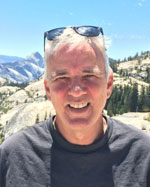
This past month the Oxford Dictionary named “post-truth” as its 2016 Word-of-the-Year. The word was chosen because it has seen a “spike in frequency this year in the context of the European Union referendum in the United Kingdom and the presidential election in the United States” and “has gone from being a peripheral term to being a mainstay in political commentary.” For scholars and educators the idea that being truthful is now optional should be deeply troubling, as it undermines the ethical and operational foundations upon which we function. In this column I want to explore the turn towards a post-truth world.
Two other similar descriptors have become more widespread in recent years — post-factual and post-rational. I believe that these terms are all part of the same sociological and political trend, but have important differences.
Continue Reading.
Recent columns from the President
FEATURE
2017 AAG Honors Announced
 The AAG has announced the selection of seven Honorees who will receive the 2017 AAG Honors in one of four categories. Recipients to be honored at an annual awards luncheon during the AAG Annual Meeting are: The AAG has announced the selection of seven Honorees who will receive the 2017 AAG Honors in one of four categories. Recipients to be honored at an annual awards luncheon during the AAG Annual Meeting are:
- Ruth Fincher, University of Melbourne, AAG Lifetime Achievement Honors
- David Robinson, Rutgers University, AAG Lifetime Achievement Honors
- Michael Storper, University of California Los Angeles, AAG Distinguished Scholarship Honors
- Patrick Bartlein, University of Oregon, AAG Distinguished Scholarship Honors
- Julie Winkler, Michigan State University, AAG Ronald F. Abler Distinguished Service Honors
- Kent Mathewson, Louisiana State University, AAG Ronald F. Abler Distinguished Service Honors
- Michael Pretes, University of North Alabama, AAG Distinguished Teaching Honors
All AAG awards will be presented at the upcoming AAG Annual Meeting in Boston, during a special awards luncheon on Sunday, April 9, 2017. |
ANNUAL MEETING
Celebrate the International Encyclopedia of Geography in Boston
Attend the editor’s panel and reception
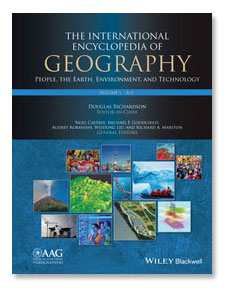 Join us in celebrating the official launch of the International Encyclopedia of Geography: People, the Earth, Environment, and Technologies in Boston! There will be a brief overview of the Encyclopedia from its general editors, followed by a Q&A session with the general and section editors of this great work. Mark your calendars for 5:20-7:00 p.m. on Friday, April 7, 2017.
Join us in celebrating the official launch of the International Encyclopedia of Geography: People, the Earth, Environment, and Technologies in Boston! There will be a brief overview of the Encyclopedia from its general editors, followed by a Q&A session with the general and section editors of this great work. Mark your calendars for 5:20-7:00 p.m. on Friday, April 7, 2017.
Following this session will be the AAG International Reception: A Celebration of the International Encyclopedia of Geography, an event with food, drinks, music, and interaction with the editors. All attendees are invited to attend.
Learn More.
Abstracts for Poster Sessions are due by Feb. 23
Posters are exhibited for informal browsing with opportunities for individual discussion with poster authors. The AAG will host all themed poster sessions in the Exhibit Hall. Please note that the AAG will add your poster to the session which most closely aligns to your poster’s theme, however if you have a strong preference you may indicate in which poster session you would like to participate in in the “Special Requests” field of the abstract submission console. All abstracts must be submitted by Feb. 23, 2017.
Learn More.
The New England Town: Not a Village
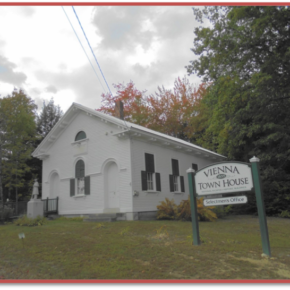
The New England town and its town meeting form of government invoke images of roadside town line signs and real democracy playing out on the floor of a wood stove heated frame town house in a small town somewhere in Boston’s hinterlands. The New England town is a municipality that encompasses an expanse of land and usually includes compact settlements (villages/hamlets) and rural areas. These political units evolved from the seventeenth century needs of people transplanting themselves from England to the shores of Massachusetts Bay. Demands of church and civic governance resulted in a blending of religious and town government affairs in early Massachusetts.
John Winthrop, first governor of the Massachusetts Bay settlements that would develop in and around the Boston locale was a principal player in both Congregationalism and establishing the underpinnings of New England town formation and administration (Rudman 1965). Towns were charged with providing local services: laying out roads and maintaining them, education, police and fire protection, overseeing the poor, passage of ordinances to protect public health and promote the general welfare of the population.
Read more.
AAG Specialty and Affinity Group Awards
Each year many AAG Specialty and Affinity Groups confer travel grants, hold paper competitions, and bestow honors and awards to their faculty and student members at the AAG Annual Meeting. Notices for these competitions may appear on the relevant specialty group’s website or listserve, or on the AAG News site.
Learn more.
Additional Annual Meeting Updates
ASSOCIATION NEWS
Important Election Information: Update Your Email Address with AAG
 The AAG election will be conducted online again, and will take place Jan. 11-Feb. 2, 2017. Each member who has an email address on record with the AAG will receive a special email with a code that will allow them to sign in to our AAG SimplyVoting website and vote. It’s important to update your email address to make sure you will be able to vote. If you know your email address is up to date with us, there’s no need to do anything further.
The AAG election will be conducted online again, and will take place Jan. 11-Feb. 2, 2017. Each member who has an email address on record with the AAG will receive a special email with a code that will allow them to sign in to our AAG SimplyVoting website and vote. It’s important to update your email address to make sure you will be able to vote. If you know your email address is up to date with us, there’s no need to do anything further.
Learn more.
Join the Effort to Make a New AP Course in GIS&T
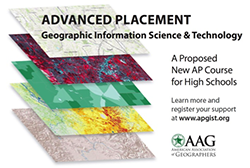 The AAG’s proposal for a new Advanced Placement course in Geographic Information Science and Technology (AP GIS&T) continues to receive strong interest from high schools, colleges, and universities across the U.S. However, in order to complete the proposal package for the College Board, the AAG needs to collect attestations of interest from at least 250 high schools.
The AAG’s proposal for a new Advanced Placement course in Geographic Information Science and Technology (AP GIS&T) continues to receive strong interest from high schools, colleges, and universities across the U.S. However, in order to complete the proposal package for the College Board, the AAG needs to collect attestations of interest from at least 250 high schools.
So far 114 high schools have registered their interest in the AP GIS&T course. The AAG invites all members to share the AP GIS&T proposal with high schools in their local community.
Learn more.
AAG Launches New Twitter Chat Series
Join the #AAGChat on Careers in Geography, Jan. 12, 2017
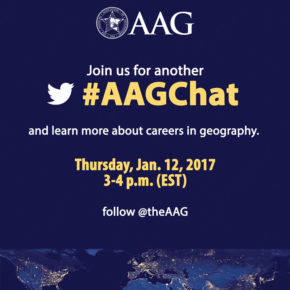 Mark your calendars and be sure to join us for an #AAGChat on careers in geography. The chat will address the many diverse career opportunities for geographers in a variety of industries and employment sectors and how geography students, graduates and early-career professionals can identify appropriate job openings. We will also discuss the many career resources available through the AAG, including our Jobs in Geography Center, Student Opportunities website, and more!
Mark your calendars and be sure to join us for an #AAGChat on careers in geography. The chat will address the many diverse career opportunities for geographers in a variety of industries and employment sectors and how geography students, graduates and early-career professionals can identify appropriate job openings. We will also discuss the many career resources available through the AAG, including our Jobs in Geography Center, Student Opportunities website, and more!
The chat will occur on Thursday, Jan. 12, 2017, from 3-4 p.m. EST. To participate in the chat, please use the hashtag, #AAGChat. Make sure to follow us on Twitter by searching for our handle, @TheAAG!
Also, be sure to visit our updated social media page to view our previous Twitter Chat held during Geography Awareness Week and learn more about our social media channels and events.
Learn more.
Invest in Geography’s Future with a Tax-Deductible Gift
Tax-deductible donations to AAG Advancing Geography Funds will help the association to generate new geographic knowledge, strengthen geographic education, increase the involvement and raise the visibility of geography in science and policy making settings, and increase geographic knowledge around the world.
Gifts to AAG Advancing Geography Funds may be designated to support specific projects and initiatives or to support the areas of greatest need. A list of AAG Advancing Geography Funds is available at www.aag.org/donate.
To fulfill your pledge by cash, check or other method, please download and complete a pledge form.
Donate Now.
RESOURCES & OPPORTUNITIES
Annual Meeting Support
AAG has a variety of opportunities for students, un-/underemployed geographers, and scholars outside the discipline to attend and participate in the Annual Meeting.
Some funding opportunities:
Learn More.
Nancy Weiss Malkiel Scholars Award Program
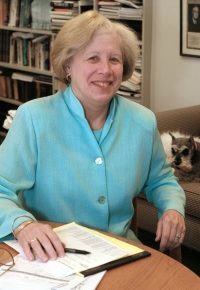 The Nancy Weiss Malkiel Scholars Award Program is now accepting applications
The Nancy Weiss Malkiel Scholars Award Program is now accepting applications
through December 15, 2016. This opportunity is for tenure-track faculty who are committed not only to research and teaching but also to building a more inclusive scholarly community. Applicants may not be going up for tenure during the award year (2017–18).
Learn More.
IN MEMORIAM
David Slater
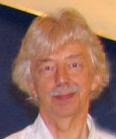
David Slater, Emeritus Professor of Political Geography at Loughborough University, UK, who was a leading critical development geographer and known for his work on Latin America, passed away on October 20, 2016.
Slater studied for a bachelor’s degree in geography at Durham University in the mid-1960s which was when he first became interested in geopolitics, seeking to understand international relations in a spatial context. He went on to the London School of Economics, where he completed a doctorate in geography in 1972.
Learn More.
OF NOTE
Geographer Michelle Behr Named Chancellor of University of Minnesota at Morris
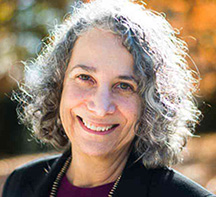 Michelle Behr, Ph.D., has been named chancellor of the University of Minnesota, Morris. Dr. Behr’s appointment is effective February 6, 2017, pending approval by the Board of Regents.
Michelle Behr, Ph.D., has been named chancellor of the University of Minnesota, Morris. Dr. Behr’s appointment is effective February 6, 2017, pending approval by the Board of Regents.
Dr. Behr is currently the Provost, Senior Vice President for Academic Affairs, and Dean of the College at Birmingham-Southern College (BSC) in Birmingham, AL. Prior to her arrival at BSC, she served variously as a faculty member, department chair, university assessment coordinator, and college dean at several public institutions of higher education.
Learn more.
Dr. Lesley-Ann Dupigny-Giroux Featured in Direction’s Magazine
AAG member Dr. Lesley-Ann Dupigny-Giroux, professor at the University of Vermont, is featured in Direction’s Magazine’s GeoInspirations series. Guest columnist Dr. Joseph Kerski interviewed her and asked her about how she was introduced to geography and her efforts to promote climate literacy and the use of geotechnologies with K-12 teachers and students, and more.
Learn more.
AAG Member Bailey Anderson Wins 2017 British Marshall Scholarship
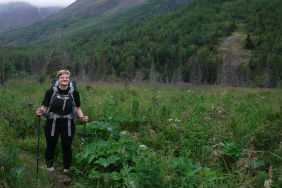 Bailey Anderson, a Liberal Arts Honors/Geography, and International Relations and Global Studi
Bailey Anderson, a Liberal Arts Honors/Geography, and International Relations and Global Studi
es major, at the University of Texas at Austin, has been awarded a 2017 British Marshall Scholarship. As a Marshall Scholar, Bailey will pursue a Master of Philosophy Degree at Oxford University in Geography and The Environment: Water Science, Policy and Management.
Learn more.
PUBLICATIONS
Pre-order ‘The International Encyclopedia of Geography’
 The AAG and an international team of distinguished editors and authors are in the final stages of preparing a new major reference work for Geography: The International Encyclopedia of Geography: People, the Earth, Environment, and Technology.
The AAG and an international team of distinguished editors and authors are in the final stages of preparing a new major reference work for Geography: The International Encyclopedia of Geography: People, the Earth, Environment, and Technology.
This 15-volume work, published by Wiley both in hard copy and online, will be an invaluable resource for libraries, geographers, GIScientists, students and academic departments around the globe. Updated annually, this Encyclopedia will be the authoritative reference work in the field of geography for decades to come.
Learn more.
January 2017 Issue of the ‘Annals of the AAG’ Now Available
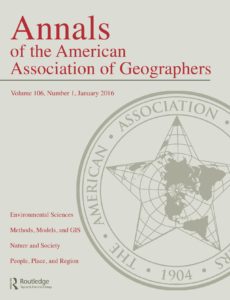 The AAG is pleased to announce that Volume 107, Issue 1 (January 2017) of the Annals of the American Association of Geographers is now available.
The AAG is pleased to announce that Volume 107, Issue 1 (January 2017) of the Annals of the American Association of Geographers is now available.
The Annals contains original, timely, and innovative articles that advance knowledge in all facets of the discipline. Articles are divided into four major areas: Environmental Sciences; Methods, Models, and Geographic Information Science; Nature and Society; and People, Place, and Region.
This issue also contains a special forum on Radical Intradisciplinarity edited by AAG past President, Mona Domosh, featuring 6 articles. It is available for free for the next two months.
Learn More.
February 2017 Issue of ‘The Professional Geographer’ Now Available
 The AAG is pleased to announce that Volume 69, Issue 1 (February 2017) of The Professional Geographer is now available.
The AAG is pleased to announce that Volume 69, Issue 1 (February 2017) of The Professional Geographer is now available.
The focus of The Professional Geographer is on short articles in academic or applied geography, emphasizing empirical studies and methodologies. These features may range in content and approach from rigorously analytic to broadly philosophical or prescriptive. The journal provides a forum for new ideas and alternative viewpoints.
Each issue, the Editor chooses one article to make freely available. In this issue you can read Re
naming and Rebranding within U.S. and Canadian Geography Departments, 1990–2014 by Amy E. Frazier and Thomas A. Wikle for free for the next 3 months.
Learn More.
December 2016 Issue of the ‘African Geographical Review’ Now Available
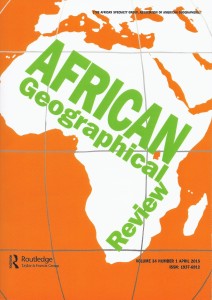 The AAG is pleased to announce that Volume 35, Issue 3 (December 2016) of the African Geographical Review is now available.
The AAG is pleased to announce that Volume 35, Issue 3 (December 2016) of the African Geographical Review is now available.
The African Geographical Review is the journal of the Africa Specialty Group of the American Association of Geographers. It provides a medium for the publication of geographical material relating to Africa, seeks to enhance the standing of African regional geography, and to promote a better representation of African scholarship. Articles cover all sub-fields of geography, and can be theoretical, empirical or applied in nature.
Learn more.
New Books in Geography – Novemer 2016
The AAG Review of Books office has released the list of the books received during the month of November.
Learn More.
ADDENDA
IN THE NEWS
Popular stories from the AAG SmartBrief
EVENTS CALENDAR
Submit News to the AAG Newsletter. To share your news, submit announcements to newsletter [at] aag [dot] org.
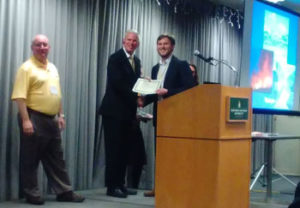

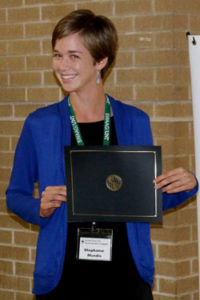
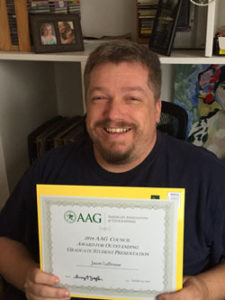
 Patrick Bartlein – The Distinguished Scholarship Honors is presented to Patrick Bartlein for his fundamental contributions to fields across and beyond physical geography, including paleo-climate, biogeography, geomorphology, meteorology, water resources, hydrology, statistics, spatial analysis, geology, ecology and archaeology. He has been integral to major international and interdisciplinary collaborations, such as the Cooperative Holocene Mapping Project (COHMAP), the Paleoclimate Modeling Intercomparison Projects (PMJP) and national and international climate change assessments. Bart (as he prefers to be called) has 200-plus publications that have been cited some I8,000 times, touching on topics ranging from water balance modeling to Holocene vegetation and wildfire interactions to the potential effects of future climate change on species distributions. A visionary scholar with a rare ability to think across multiple temporal and spatial scales, Bart bas illuminated climatological phenomena from decades to billions of years in time and from meters to continents in space. The AAG is proud to honor him with its Distinguished Scholarship Honors.
Patrick Bartlein – The Distinguished Scholarship Honors is presented to Patrick Bartlein for his fundamental contributions to fields across and beyond physical geography, including paleo-climate, biogeography, geomorphology, meteorology, water resources, hydrology, statistics, spatial analysis, geology, ecology and archaeology. He has been integral to major international and interdisciplinary collaborations, such as the Cooperative Holocene Mapping Project (COHMAP), the Paleoclimate Modeling Intercomparison Projects (PMJP) and national and international climate change assessments. Bart (as he prefers to be called) has 200-plus publications that have been cited some I8,000 times, touching on topics ranging from water balance modeling to Holocene vegetation and wildfire interactions to the potential effects of future climate change on species distributions. A visionary scholar with a rare ability to think across multiple temporal and spatial scales, Bart bas illuminated climatological phenomena from decades to billions of years in time and from meters to continents in space. The AAG is proud to honor him with its Distinguished Scholarship Honors. Ruth Fincher – The Lifetime Achievement Honors is presented to Ruth Fincher for her contributions to geographical research, teaching, and service. Her dual focus on the lived experiences of disadvantaged populations and the political-economic structures within which those populations struggle has been a core part of her work throughout her career. So too has a focus on local issues, from neighborhood redevelopment to immigration and identity to rising sea levels. Beyond Fincher’s policy-relevant research, she has served on multiple advisory boards and committees at the national and international levels; has been elected Vice-President of the International Geographical Union; and has been honored as a Member of the Order of Australia. Her advocacy for geography within her university and on an international level has strengthened the health of the discipline beyond her outstanding research and teaching.
Ruth Fincher – The Lifetime Achievement Honors is presented to Ruth Fincher for her contributions to geographical research, teaching, and service. Her dual focus on the lived experiences of disadvantaged populations and the political-economic structures within which those populations struggle has been a core part of her work throughout her career. So too has a focus on local issues, from neighborhood redevelopment to immigration and identity to rising sea levels. Beyond Fincher’s policy-relevant research, she has served on multiple advisory boards and committees at the national and international levels; has been elected Vice-President of the International Geographical Union; and has been honored as a Member of the Order of Australia. Her advocacy for geography within her university and on an international level has strengthened the health of the discipline beyond her outstanding research and teaching. Kent Mathewson – The Ronald F. Abler Distinguished Service Honors is presented to Kent Mathewson for his tireless and frequently ‘ behind-the-scenes ‘ advocacy for geographic scholarship and historiography. He is particularly appreciated for his tireless work “recognizing and celebrating the work of book authors” through his long-time work as Book Review editor and most recently as Editor-in-Chief for The AAG Review of Books. His unwavering support for book authors is described as a contribution that is “essential to the intellectual vigor of our discipline.”
Kent Mathewson – The Ronald F. Abler Distinguished Service Honors is presented to Kent Mathewson for his tireless and frequently ‘ behind-the-scenes ‘ advocacy for geographic scholarship and historiography. He is particularly appreciated for his tireless work “recognizing and celebrating the work of book authors” through his long-time work as Book Review editor and most recently as Editor-in-Chief for The AAG Review of Books. His unwavering support for book authors is described as a contribution that is “essential to the intellectual vigor of our discipline.” Michael Pretes – The 2017 Distinguished Teaching Honors is presented to Michael Pretes for his contributions to geographic education both within and outside the classroom. He has been a faculty member at the University of North Alabama since 2006 where he is an exemplary teacher-scholar. His students and colleagues extoll his passion for geography and his ability to instill a love and respect for geography in his students. In 2013 he was awarded with the university’s most distinguished award, the Phi Kappa Phi Eleanor Gaunder Award for excellence in undergraduate education. In addition, in 2015 he received the Southeast Geographers Excellence in Teaching Award. He held teaching and research positions at several institutions in the United States, and abroad. In addition to his work with undergraduate and graduate students he has reached out to students in secondary classrooms and members of communities where he lived and worked. Pretes is highly active in geographic education through various organizations such as the American Association of Geographers, the Southeast Division of the AAG, the Association of Pacific Coast Geographers, the Royal Geographical Society, the Arctic Institute of North America and the American Association of Hispanics in Higher Education.
Michael Pretes – The 2017 Distinguished Teaching Honors is presented to Michael Pretes for his contributions to geographic education both within and outside the classroom. He has been a faculty member at the University of North Alabama since 2006 where he is an exemplary teacher-scholar. His students and colleagues extoll his passion for geography and his ability to instill a love and respect for geography in his students. In 2013 he was awarded with the university’s most distinguished award, the Phi Kappa Phi Eleanor Gaunder Award for excellence in undergraduate education. In addition, in 2015 he received the Southeast Geographers Excellence in Teaching Award. He held teaching and research positions at several institutions in the United States, and abroad. In addition to his work with undergraduate and graduate students he has reached out to students in secondary classrooms and members of communities where he lived and worked. Pretes is highly active in geographic education through various organizations such as the American Association of Geographers, the Southeast Division of the AAG, the Association of Pacific Coast Geographers, the Royal Geographical Society, the Arctic Institute of North America and the American Association of Hispanics in Higher Education. David Robinson – The AAG Life Achievement Honors is presented to David Robinson because he is a multi-dimensional geographer who has achieved extraordinary success and impact in many domains simultaneously. As a researcher, he is a leading figure in the fields of climate science and climatology and one the world’s foremost experts on global snow cover. As New Jersey State Climatologist for the past 25 years, he is among the most publicly prominent geographers in the New York-New Jersey region, granting hundreds of media interviews each year while also overseeing a publicly accessible statewide climate and weather data network. As a long-serving department chair at Rutgers, Robinson fostered a culture of success that combined scholarly achievement with mentorship, collegiality and mutual respect among all members of the department.
David Robinson – The AAG Life Achievement Honors is presented to David Robinson because he is a multi-dimensional geographer who has achieved extraordinary success and impact in many domains simultaneously. As a researcher, he is a leading figure in the fields of climate science and climatology and one the world’s foremost experts on global snow cover. As New Jersey State Climatologist for the past 25 years, he is among the most publicly prominent geographers in the New York-New Jersey region, granting hundreds of media interviews each year while also overseeing a publicly accessible statewide climate and weather data network. As a long-serving department chair at Rutgers, Robinson fostered a culture of success that combined scholarly achievement with mentorship, collegiality and mutual respect among all members of the department. Michael Storper – The Distinguished Scholarship Honors is presented to Michael Storper for his outstanding record of scholarly achievement and innovative contributions to the fields of global economic development and the geography of urban and regional systems. He has held academic positions at highly reputable institutions in both the United States and Europe. His exceptional research has led to widely cited and highly influential scholarly publications and foundational contributions to economic and urban geography and related disciplines. The depth and quality of his work has put him in a category of scholarship that is truly deserving of this prestigious AAG award.
Michael Storper – The Distinguished Scholarship Honors is presented to Michael Storper for his outstanding record of scholarly achievement and innovative contributions to the fields of global economic development and the geography of urban and regional systems. He has held academic positions at highly reputable institutions in both the United States and Europe. His exceptional research has led to widely cited and highly influential scholarly publications and foundational contributions to economic and urban geography and related disciplines. The depth and quality of his work has put him in a category of scholarship that is truly deserving of this prestigious AAG award. Julie Winkler – The Ron Abler Distinguished Service Honors is presented to Julie Winkler in recognition of her sustained and committed work to the AAG, the discipline of geography, her department, and her state and community. She has served as an officer in several national and international professional organizations; on the editorial boards of numerous high ranking journals (17 on the board of the Annals of the AAG); and has brought her insights to bear in guiding several departments through programmatic reviews. Her career has been marked by those things held as noteworthy by Ron Abler – a desire to sustain the breadth and vitality of geography, support of faculty in their careers, and a commitment to move the field in a direction that is marked by integrative approaches. She has done this exceptional service without sacrificing her contribution to research and teaching.
Julie Winkler – The Ron Abler Distinguished Service Honors is presented to Julie Winkler in recognition of her sustained and committed work to the AAG, the discipline of geography, her department, and her state and community. She has served as an officer in several national and international professional organizations; on the editorial boards of numerous high ranking journals (17 on the board of the Annals of the AAG); and has brought her insights to bear in guiding several departments through programmatic reviews. Her career has been marked by those things held as noteworthy by Ron Abler – a desire to sustain the breadth and vitality of geography, support of faculty in their careers, and a commitment to move the field in a direction that is marked by integrative approaches. She has done this exceptional service without sacrificing her contribution to research and teaching. Nina Feldman, a former intern with AAG and the Geography and Map Division of the Library of Congress, shares why she chose a career in GIS and Geography in a very poignant guest blog post for
Nina Feldman, a former intern with AAG and the Geography and Map Division of the Library of Congress, shares why she chose a career in GIS and Geography in a very poignant guest blog post for 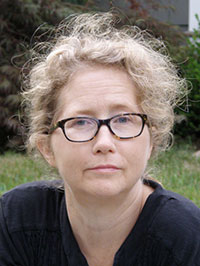 Cassidento brings a wealth of editorial expertise and experience to the AAG publications. She has worked previously with major scholarly publishing houses, and for several years with the AAG on its journals, serving as managing editor of three of its flagship journals, including the Annals of the American Association of Geographers, the AAG Review of Books, and GeoHumanities. Jennifer also provided outstanding support and played a central role in the production of the forthcoming 15-volume AAG International Encyclopedia of Geography: People, the Earth, Environment, and Technology, which will be published in March of 2017.
Cassidento brings a wealth of editorial expertise and experience to the AAG publications. She has worked previously with major scholarly publishing houses, and for several years with the AAG on its journals, serving as managing editor of three of its flagship journals, including the Annals of the American Association of Geographers, the AAG Review of Books, and GeoHumanities. Jennifer also provided outstanding support and played a central role in the production of the forthcoming 15-volume AAG International Encyclopedia of Geography: People, the Earth, Environment, and Technology, which will be published in March of 2017.
 The AAG has announced the selection of seven Honorees who will receive the 2017 AAG Honors in one of four categories. Recipients to be honored at an annual awards luncheon during the AAG Annual Meeting are:
The AAG has announced the selection of seven Honorees who will receive the 2017 AAG Honors in one of four categories. Recipients to be honored at an annual awards luncheon during the AAG Annual Meeting are: Join us in celebrating the official launch of the International Encyclopedia of Geography: People, the Earth, Environment, and Technologies in Boston! There will be a brief overview of the Encyclopedia from its general editors, followed by a Q&A session with the general and section editors of this great work. Mark your calendars for 5:20-7:00 p.m. on Friday, April 7, 2017.
Join us in celebrating the official launch of the International Encyclopedia of Geography: People, the Earth, Environment, and Technologies in Boston! There will be a brief overview of the Encyclopedia from its general editors, followed by a Q&A session with the general and section editors of this great work. Mark your calendars for 5:20-7:00 p.m. on Friday, April 7, 2017.
 The AAG election will be conducted online again, and will take place Jan. 11-Feb. 2, 2017. Each member who has an email address on record with the AAG will receive a special email with a code that will allow them to sign in to our AAG SimplyVoting website and vote. It’s important to update your email address to make sure you will be able to vote. If you know your email address is up to date with us, there’s no need to do anything further.
The AAG election will be conducted online again, and will take place Jan. 11-Feb. 2, 2017. Each member who has an email address on record with the AAG will receive a special email with a code that will allow them to sign in to our AAG SimplyVoting website and vote. It’s important to update your email address to make sure you will be able to vote. If you know your email address is up to date with us, there’s no need to do anything further. The AAG’s proposal for a new Advanced Placement course in Geographic Information Science and Technology (AP GIS&T) continues to receive strong interest from high schools, colleges, and universities across the U.S. However, in order to complete the proposal package for the College Board, the AAG needs to collect attestations of interest from at least 250 high schools.
The AAG’s proposal for a new Advanced Placement course in Geographic Information Science and Technology (AP GIS&T) continues to receive strong interest from high schools, colleges, and universities across the U.S. However, in order to complete the proposal package for the College Board, the AAG needs to collect attestations of interest from at least 250 high schools. Mark your calendars and be sure to join us for an #AAGChat on careers in geography. The chat will address the many diverse career opportunities for geographers in a variety of industries and employment sectors and how geography students, graduates and early-career professionals can identify appropriate job openings. We will also discuss the many career resources available through the AAG, including our Jobs in Geography Center, Student Opportunities website, and more!
Mark your calendars and be sure to join us for an #AAGChat on careers in geography. The chat will address the many diverse career opportunities for geographers in a variety of industries and employment sectors and how geography students, graduates and early-career professionals can identify appropriate job openings. We will also discuss the many career resources available through the AAG, including our Jobs in Geography Center, Student Opportunities website, and more! The Nancy Weiss Malkiel Scholars Award Program is now accepting applications
The Nancy Weiss Malkiel Scholars Award Program is now accepting applications
 Michelle Behr, Ph.D., has been named chancellor of the University of Minnesota, Morris. Dr. Behr’s appointment is effective February 6, 2017, pending approval by the Board of Regents.
Michelle Behr, Ph.D., has been named chancellor of the University of Minnesota, Morris. Dr. Behr’s appointment is effective February 6, 2017, pending approval by the Board of Regents.
 Bailey Anderson, a Liberal Arts Honors/Geography, and International Relations and Global Studi
Bailey Anderson, a Liberal Arts Honors/Geography, and International Relations and Global Studi The AAG is pleased to announce that Volume 107, Issue 1 (January 2017) of the Annals of the American Association of Geographers is now available.
The AAG is pleased to announce that Volume 107, Issue 1 (January 2017) of the Annals of the American Association of Geographers is now available. The AAG is pleased to announce that Volume 69, Issue 1 (February 2017) of The Professional Geographer is now available.
The AAG is pleased to announce that Volume 69, Issue 1 (February 2017) of The Professional Geographer is now available. The AAG is pleased to announce that Volume 35, Issue 3 (December 2016) of the African Geographical Review is now available.
The AAG is pleased to announce that Volume 35, Issue 3 (December 2016) of the African Geographical Review is now available.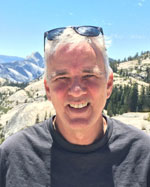 This past month the
This past month the 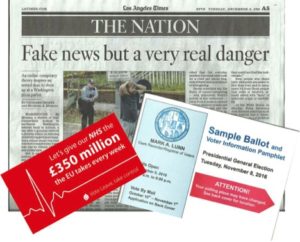 Two other similar descriptors have become more widespread in recent years — post-factual and post-rational. I believe that these terms are all part of the same sociological and political trend, but have important differences. Post-factual does not necessarily mean being untruthful, it may represent situations in which pertinent factual information is either not sought, not considered, not valued, or is simply reviled. The term post-truth implies deliberate provision or knowing acceptance of information that is known to be untruthful. I would suggest the deliberate suppression of factual information would also fall under this rubric. Post-rational suggests situations in which facts, reasoning and logic are deemed unnecessary or even loathed when decisions are taken. The term post-truth is widely used in a sense that captures all three of these issues. In the context of western philosophy and history, an increasingly post-truth world can be seen as a rejection of 300 years of scientific, socioeconomic and political development that was initiated by the Age of Enlightenment in the 18th century.
Two other similar descriptors have become more widespread in recent years — post-factual and post-rational. I believe that these terms are all part of the same sociological and political trend, but have important differences. Post-factual does not necessarily mean being untruthful, it may represent situations in which pertinent factual information is either not sought, not considered, not valued, or is simply reviled. The term post-truth implies deliberate provision or knowing acceptance of information that is known to be untruthful. I would suggest the deliberate suppression of factual information would also fall under this rubric. Post-rational suggests situations in which facts, reasoning and logic are deemed unnecessary or even loathed when decisions are taken. The term post-truth is widely used in a sense that captures all three of these issues. In the context of western philosophy and history, an increasingly post-truth world can be seen as a rejection of 300 years of scientific, socioeconomic and political development that was initiated by the Age of Enlightenment in the 18th century.